 Reviewed by Dr. Michael Kessler, DC — Graves’ eye disease, also known as Graves’ ophthalmopathy or thyroid eye disease, is a rare condition that can affect people with hyperthyroidism.
Reviewed by Dr. Michael Kessler, DC — Graves’ eye disease, also known as Graves’ ophthalmopathy or thyroid eye disease, is a rare condition that can affect people with hyperthyroidism.
Hyperthyroidism is most commonly caused by a condition known as Graves’ disease. Yet Graves’ disease and Graves’ eye disease are not necessarily related in the way you might think.
Instead, the two conditions get caught up in a rather strange cycle.
What Is Graves’ Disease?
Graves’ disease (not specifically affecting eyes) is an autoimmune disorder that causes hyperthyroidism (overactive thyroid). The disease causes the immune system to attack the healthy tissue of the thyroid gland and boost production of thyroid hormone.
The eyes happen to be particularly vulnerable to Graves’ disease because they have muscles and connective tissues that appear very similar to those in the thyroid gland, leading antibodies to attack both locales.
Treating Graves’ disease-related hyperthyroidism, however, will not cure Graves’ eye disease. Each condition runs its own path.
Thyroid Function and Hyperthyroidism
Before we examine the symptoms and potential causes of Graves’ eye disease, it’s important to go over the basics of thyroid function.
The thyroid is a butterfly-shaped endocrine gland found in the lower portion of the front of the neck. Its job is to make hormones, secreted in the blood, to perform a variety of metabolic purposes. It helps the body:
- Use energy
- Store energy
- Keep major organs (brain, heart, muscles) working properly
- Regulate internal temperature
- Manage cell metabolism and growth
Thyroid disease comes in two forms: hypothyroidism and hyperthyroidism.
Hypothyroidism is when the thyroid is underactive and not producing enough thyroid hormone. It is characterized by symptoms such as:
- Fatigue
- Slow heartbeat
- Weight gain
- Sensitivity to cold
- Aches
- Constipation
- Brain fog
- Depression
- Slow movement
- Muscle cramps
Hyperthyroidism is an overactive thyroid, meaning it produces too much thyroid hormone. Many of its symptoms are the opposite of hypothyroidism. It is characterized by:
- Fast heartbeat
- Palpitations
- Sweating
- Irritability
- Heightened blood pressure
- Unexplained weight loss
- Heat intolerance/sensitivity to heat
- Hair loss/changes in hair quality
Graves’ disease can cause hyperthyroidism, but hyperthyroidism does not cause Graves’ eye disease.
Graves’ Eye Disease Symptoms
Common symptoms of Graves’ eye disease include:
- Redness and pain in and around the eye
- Puffiness
- Bulging eyes/eyelid retraction
- Dry eye and irritation (generally occurring when eyelids cannot close completely over bulging eyes)
More progressive swelling may result in:
- Increased pressure in the eye socket
- Pressure pain/deep headaches that worsen with eye movements.
- Decreased vision (caused by swollen tissues pushing on the optic nerve)
- Eyes pushed forward in the socket—bulging or “staring” appearance
- Restricted natural eye movement, resulting in double vision.
While a common fear, blindness is extremely rare among patients with Graves’ eye disease.
Graves’ Eye Disease Causes and Risk Factors
The symptoms of Graves’ eye disease are a direct result of immune attacks on the tissue in the eye socket. Swelling and scarring lead to the symptoms mentioned above.
The cause of Graves’ disease, however, is currently unknown.
Approximately one million people in the United States have Graves’ eye disease.
Gender and smoking status seem to play major roles in risk. Women are five to six times more likely to get Graves’ eye disease than men.
Smokers also have a much higher risk. They are also significantly more likely to experience severe symptoms than non-smokers.
Although Graves’ disease and Graves’ eye disease are rooted in the immune system attacking healthy tissue, one disease does not necessarily cause the other. They might not even occur at the same time.
Graves’ Eye Disease Treatments
Symptoms can range from mild to severe; however, most people with Graves’ eye disease are likely to experience some degree of eye bulging or eyelid retraction.
Most people with mild-to-moderate cases will notice periods of spontaneous improvement over the course of a few years, or they may just adapt to it.
Roughly 10% to 20% of patients develop severe symptoms, and 10% may experience threats to vision.
Treatments will depend on the severity of the patient’s condition and their doctor’s approach.
Current treatments include:
- Steroids: Steroids like hydrocortisone and prednisone are used to treat swelling and control inflammation.
- Eyelid surgery: Doctors may recommend eyelid surgery if the patient experiences increasing difficulty closing their eyelids.
- Eye muscle surgery: Scar tissue can sometimes cause one or more eye muscles to shorten and pull the eye out of alignment. The goal of the surgery is to realign the eye to improve double vision by severing and reattaching muscle tissue further back in the eye socket.
- Radiation therapy: This is often used in conjunction with steroid therapy to help target antibodies and quell inflammation in people with moderate-to-severe thyroid eye disease.
Managing Graves’ Eye Disease Naturally
There are less invasive ways to minimize the discomfort of Graves’ eye disease. If your condition is mild-to-moderate, you may benefit from the following:
- Sunglasses: Graves’ eye disease can make your eyes more vulnerable and sensitive to the elements. Sunglasses can help by easing the effects of harmful UV rays, light, and wind on protruding eyes.
- Cold compress: Moisture from a cool compress may provide relief from pain and swelling.
- Lubricating eye drops: Eye drops with lubricant may help relieve symptoms like itchiness around the eye. They could also help reduce scratchiness caused by a potentially tighter eyelid, and may be particularly useful at bedtime. Do not use options that contain redness removers.
- Elevating the head: When lying in bed, try using an extra pillow to prop your head up higher than the rest of your body. This may help prevent swelling and increased pressure in your eyes and head.
- Prisms: If you’re experiencing double vision, your doctor may prescribe lenses with prisms.
Graves’ Eye Disease: Rare but Treatable
Graves’ eye disease is a rare condition that, while uncomfortable and concerning, is treatable and unlikely to result in vision loss. Unfortunately, treating hyperthyroidism will not carry over to the eyes. If you’re concerned about your potential to develop Graves’ eye disease, talk to your doctor.
Article Sources (+)
“Graves’ Eye Disease,” American Thyroid Association, 2020; https://www.thyroid.org/graves-eye-disease/, last accessed November 13, 2020.
“Graves’s Disease,” National Institute of Health, September 2017; https://www.niddk.nih.gov/health-information/endocrine-diseases/graves-disease, last accessed November 13, 2020.
“Thyroid Disease,” Cleveland Clinic, April 19, 2020; https://my.clevelandclinic.org/health/diseases/8541-thyroid-disease, last accessed November 13, 2020.
“Thyroid Eye Disease,” National Organization for Rare Disorders, 2020; https://rarediseases.org/rare-diseases/thyroid-eye-disease, last accessed November 13, 2020.
